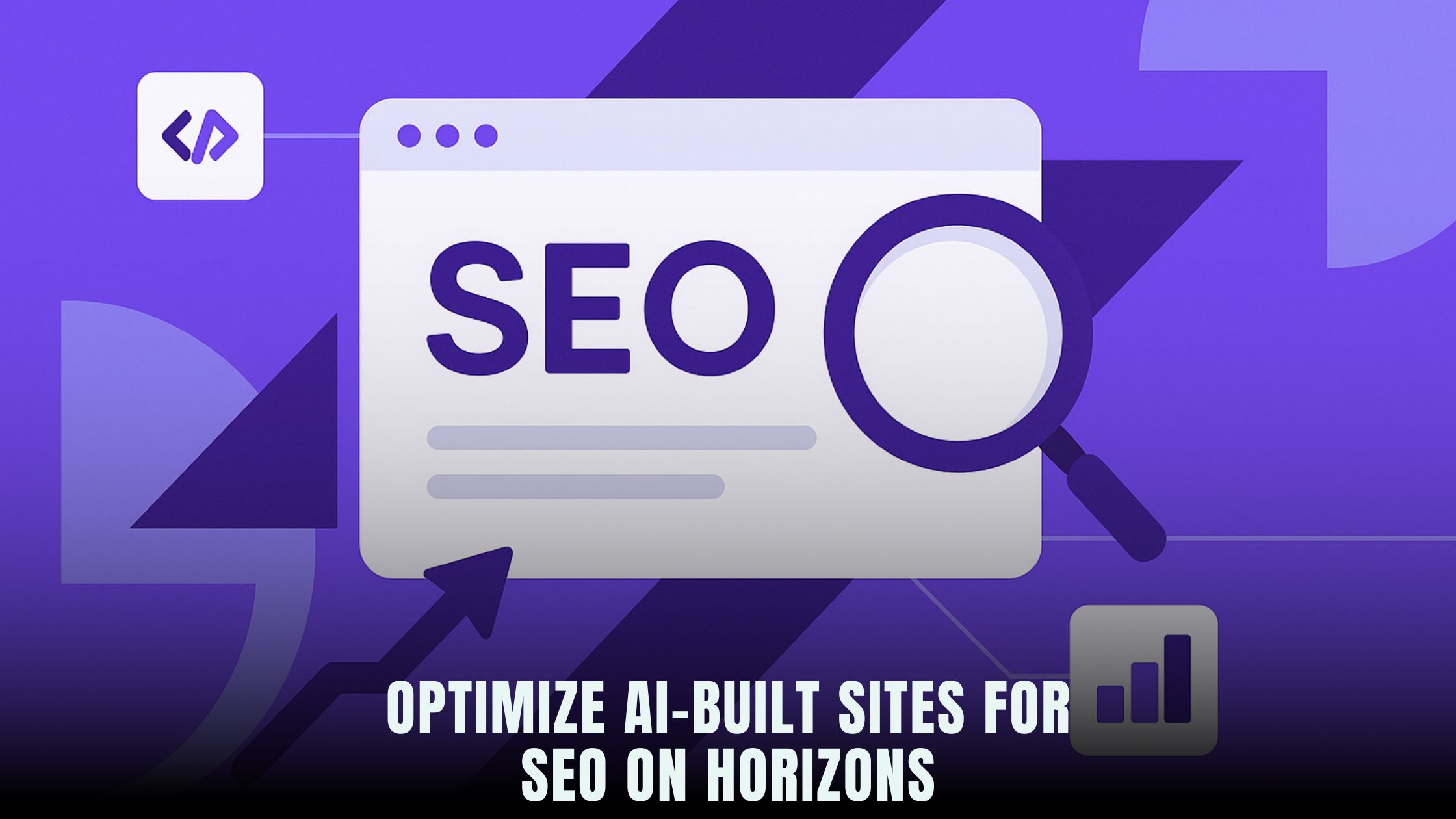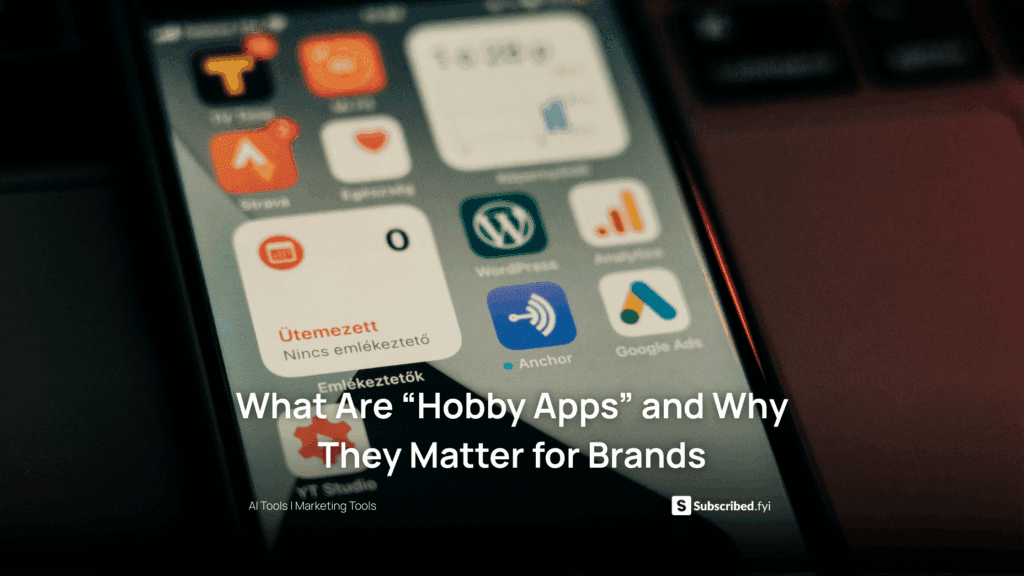How to Optimize AI‑Built Sites for SEO on Horizons?
- WebOps Platforms Bug Tracking & Feedback Software Web Development & Design Website Builder


You built a site fast. Now you want it to rank. The good news: the SEO basics—titles, descriptions, schema, sitemaps—are baked right into Hostinger Horizons. If you’re still scanning the market, this roundup of the Best AI-Powered Website Builders shows what’s out there, but the real advantage on Horizons is how the SEO controls sit next to design and content in one simple chat-driven workspace.
Speed also matters. Search engines reward sites that load fast and render clean on mobile. Because Hostinger Horizons bundles hosting, SSL, and a global CDN, your pages start on a strong technical footing. If you want to test other flows for inspiration—say a quick prototype in Lovable or a layout sketch in Bolt—you can, but your production SEO setup is easiest when site, domain, and performance live together inside Horizons.
Why SEO on an AI-Built Site Is Different (and Easier)
Traditional builders often spread SEO settings across plugins and hidden panels. On Horizons, you adjust meta tags, indexing rules, and structured data in context while you build. The AI chat can surface the right panel the moment you ask for it, so you’re not hunting through menus. That cuts guesswork and helps you publish content that search engines can crawl and understand on day one.
AI doesn’t replace sound strategy, though. You still need clear keywords, clean structure, and helpful content. Think of Horizons as the accelerator that handles the technical blocking and tackling while you focus on message and value.
Set the Foundations: Meta Titles, Descriptions, and Canonicals
Open any page in your project and ask, “Open the SEO panel.” You’ll see fields for Page Title, Meta Description, and Canonical URL. Horizons shows a live snippet preview with character counters, so you avoid cut-offs in search results. If you have near-duplicate pages, set a canonical to point engines to the main version. This is useful for landing pages that share a product but target different audiences.
At the project level, set a default title pattern—like “%PageTitle% | BrandName”—so new pages ship with consistent branding. If you ever rebrand, a single update pushes across the site.
Control Indexing with robots.txt and Meta Robots
Sometimes you want pages live but not indexed—staging pages, thank-you screens, or experiment variants. In Horizons, you can toggle indexing per page. For broader rules, click the site settings and edit robots.txt to disallow crawlers from folders you never want in results, like /cart/ or /admin/. The platform generates a clean robots.txt and places it at the root.
If you need a temporary block while drafting a campaign, set meta noindex, nofollow on that page. When you’re ready, flip to index, follow and publish.
Generate and Submit XML Sitemaps
Search engines find content faster when your sitemap is tidy. Horizons auto-generates an XML sitemap and updates it whenever you publish. Ask the AI, “Show my sitemap URL,” and it will display the link for Search Console. Once you verify your domain, submit the sitemap there for faster discovery. If you create a separate blog subfolder later, Horizons adds it to the existing sitemap index.
Build Fast Pages: Performance and Core Web Vitals
Performance is SEO. Slow pages lose rank and conversions. Because Hostinger Horizons runs on optimized hosting with built-in SSL and CDN, you’ve got fewer knobs to turn. Still, there are smart moves you can make:
Use image compression and responsive sizes. Ask, “Optimize all hero images to responsive WebP,” and Horizons will generate multiple sizes and swap them in srcset. Enable lazy loading below the fold so images don’t block the first paint. Use the real-time sandbox to simulate a mid-range phone on 3G and watch the page paint as you scroll.
If you want to experiment with performance concepts before committing changes, tools like Tempo or V0 are handy for quick mockups. But when it’s time to go live with a fast, secure site, keep your optimizations close to home inside Horizons.
Structure Your Site: Navigation, Slugs, and Internal Links
Clear structure helps search engines and visitors. Keep URLs short and descriptive (/pricing, /about, /blog/seo-basics). Horizons lets you edit slugs directly under the page title, and it autogenerates breadcrumbs you can enable in the layout panel. Add internal links from higher-authority pages—home, pricing, top blog posts—to deeper articles. The AI can suggest internal link targets as you write; ask for “related links to our beginner SEO guide and pricing.”
If you test content elsewhere—say a draft in Lazy AI or Fine AI—bring it back into Horizons to lock in clean slugs, canonical routes, and structured data.
Nail On-Page Elements: Headings, Media, and Accessibility
Headings should tell a story. Use one H1 per page, then H2/H3 to group ideas. Keep paragraphs short and readable. Horizons’ editor shows your heading outline so you can spot gaps. For images, write descriptive alt text. Ask, “Audit this page for missing alt text,” and Horizons will list any images that need attention and propose suggestions you can accept or refine.
Accessibility upgrades—clear contrast, focus states, keyboard navigation—help users and SEO. Horizons scans for common issues and flags them in the sandbox, so you fix them before publishing.
Add Structured Data (Schema) the Easy Way
Schema helps Google understand what your page represents. Horizons includes JSON-LD templates for Organization, LocalBusiness, Product, Article, HowTo, FAQ, and Breadcrumbs. Open the SEO panel, choose the schema type, and fill the fields. For FAQs, you can convert a short Q&A block into structured FAQ in one click; Horizons inserts the JSON-LD behind the scenes. For a product page, point schema fields at your price, SKU, and availability elements so rich results stay updated as your catalog changes.
If you’re curious to prototype schema snippets by hand, editors like Cursor or Windsurf can be helpful sandboxes. But once you’ve got the structure right, apply it in Horizons to keep everything centralized.
Build Topic Clusters and Pillar Pages
Search engines reward depth. Pick a pillar theme (e.g., “Small Business SEO”) and write a pillar page that summarizes the topic with links to detailed subpages—keyword research, local SEO, site speed, schema. In Horizons, create that pillar, then ask the AI, “Generate a cluster outline with 8 subpages and internal link suggestions.” You still write the content, but the link map gives crawlers and readers a clear path.
Use consistent templates so your cluster pages share design and navigation. If you want a quick feel for alternative page styles, browse the AI-Powered Website Builders List for inspiration while keeping your main build in Horizons.
Multilingual SEO: Hreflang and Locale-Aware Content
If your audience is global, you’ll want language-specific pages. Hostinger Horizons supports 80+ languages and auto-generates hreflang tags for translated versions. Ask, “Clone this page into Spanish and French and link them with hreflang,” and Horizons will create localized routes and wire up the tags. You can auto-translate as a draft and then refine the copy for nuance. For local search, adapt examples, currency, and units to each market.
To keep exploring tools that can assist your multilingual workflow, the Vibe Coding Directory is a good place to discover utilities you might pair with your Horizons build.
Image SEO and Media Delivery
File names still matter. Upload ceramic-coffee-mug-side-angle.webp instead of IMG_2039.webp. Set alt text that describes the image and how it serves the page. Use captions when they add context. For galleries and product grids, enable lazy load and specify width/height to reduce layout shift. Horizons’ CDN serves the best format per browser, so WebP or AVIF will deliver where supported and fall back when needed.
Local SEO and Knowledge Panels
If you operate a physical location, create a Location page with NAP (name, address, phone) exactly as it appears on your Google Business Profile. Add LocalBusiness schema and embed a map. On your Contact page, include driving directions and business hours. Horizons’ schema editor lets you mark holidays and special hours from the same interface.
Blog and Content Cadence
A steady cadence of helpful posts builds topical authority. Draft posts in Horizons, define the URL slug early, and write to search intent. Add internal links to and from your pillar pages. Use author bios and Article schema so your posts can earn rich results. When you hit Publish, Horizons updates your sitemap automatically.
If you like brainstorming styles or prompts elsewhere, quick ideation tools like Lovable or Bolt can spark ideas. Finalize structure and SEO in Horizons to keep sitemaps, robots, and schema aligned.
Analytics, Search Console, and A/B Testing
Connect Google Analytics and Search Console right from the dashboard. Horizons exposes simple slots for your GA property and verification tags, plus a toggle to inject them site-wide. Use Search Console to monitor impressions, clicks, and coverage issues. When a page underperforms, create an A/B test inside Horizons: clone the page, tweak the hero headline or CTA order, and split traffic. The built-in reporting shows which variant wins on click-through or conversions so you can merge the result.
If you want to prototype an experiment flow first, tools in the AI builder ecosystem—like Tempo or V0—can help you think through variations. Then convert the best idea into a Horizons variant to test with real traffic.
Technical Health: Redirects, 404s, and Crawl Budget
Old URLs happen—rebrands, new navigation, trimmed categories. Set permanent (301) redirects in Horizons to carry link equity to the new destination. Customize your 404 page so lost visitors can find key links instead of bouncing. For large sites, keep pagination crawlable and avoid infinite loops. Use robots to exclude faceted parameters you don’t want indexed. Horizons’ redirect manager and robots controls live in the same site settings, which keeps your crawl budget in shape.
Common SEO Mistakes on New Builds (and Quick Fixes)
Blocking the whole site with a global noindex is more common than you’d think. Before launch, ask Horizons, “Audit the site for any noindex pages.” Fix intentional blocks only. Duplicate content is another issue. If you cloned a page to draft a new version, set the canonical on the draft to the original until the copy is ready.
Thin pages can drag down quality. If a page exists only for a design experiment and has little content, either improve it or remove it from indexing. Horizons’ sandbox shows how crawlers see the page; use it to catch empty sections or broken links before publishing.
Content That Earns Links
SEO gets easier when people link to you. Publish data-backed posts, how-to guides, and checklists your customers actually use. Offer an embeddable widget or calculator on a resources page; provide simple copy-paste code. Create one useful thing per month and share it with partners and communities. Horizons’ fast publishing loop lets you ship those resources without overhead—focus on value, not setup.
When to Benchmark Against Other Tools
There’s value in seeing how other builders handle templates and styles. Skim feature pages for Windsurf, Cursor, Lazy AI, and Fine AI to get visual ideas. Then bring those ideas back and implement them with clean URLs, clear headings, and structured data in Horizons so your SEO foundation stays consistent.
Where Hostinger Horizons Fits in Your SEO Workflow
Hostinger Horizons makes SEO setup a normal part of building, not a separate project. In one place, you set page titles and descriptions, manage robots and sitemaps, add JSON-LD schema, and preview changes in a real-time sandbox. Your hosting, SSL, and CDN are included, which means technical speed and security are handled from the start. You can create language variants with automatic hreflang, customize canonical routes, and wire up analytics without touching code.
Beyond settings, Hostinger Horizons helps you iterate. Spin up A/B variants, split traffic, and merge winners. Use the sandbox to test mobile performance and accessibility before you publish. If you need help, expert support is available 24/7, and because domain, site, and SEO live together, your questions get solved in context. The result is a site that ranks better because it’s fast, understandable, and updated often.
Ship a Search-Ready Site—Then Keep Improving
SEO isn’t a one-time checklist; it’s steady work on content, structure, and speed. With Horizons, the heavy lifting is close at hand. Set clean meta and schema, keep pages fast, link your topics, and watch analytics to guide your next post or tweak. When everything from sitemaps to A/B testing is one command away, you spend less time configuring and more time publishing the pages that win.





